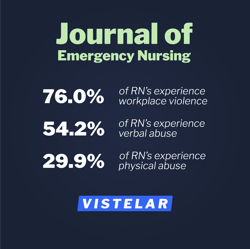Nurses embody compassion, empathy, and love in their everyday interactions with patients, making them an indispensable part of healthcare. However, their safety is often compromised in the line of duty, particularly in today's climate of heightened tensions and workplace violence. As a former U.S. Marine Corps veteran and someone who grew up in a violent environment, I’ve seen firsthand the effects of violence and understand the importance of safety. Now, as a professional dedicated to training healthcare workers, my focus is on empowering these caring individuals to be both compassionate and safe.
In this article, I’ll share my personal story, highlight the challenges nurses face in terms of workplace violence, and discuss strategies that can help healthcare workers protect themselves without sacrificing the empathy that makes them so special. One thing I emphasize to every healthcare professional I train is this: *Your paycheck will never reflect the lives you impact.* Compassion is at the heart of nursing, but so is the need for personal safety.
Realities of Environmental Risk
Nurses operate in a profession where compassion is more than just a virtue; it’s a necessity. Nurses provide emotional support, physical care, and a sense of security to patients in vulnerable conditions. From offering a smile during difficult times to administering life-saving treatments, their impact is profound. This level of care, however, can sometimes put nurses in dangerous situations, especially when patients or their families are under extreme stress.
Personal Story: Nurse Jones
My connection with nurses is deeply personal. I grew up in a rough neighborhood, and my mother, who struggled with drug addiction, was frequently in and out of emergency rooms. I spent many of my formative years waiting for her to be discharged from hospitals, committed to mental health facilities, or sent to rehab. During those tough times, a particular nurse, whom I’ll call Nurse Jones, made a lasting impact on my life. She didn’t just treat my mom—she cared for me and my younger brother, too.
Whenever we waited in the ER, Nurse Jones would offer us food, a smile, and words of encouragement. She saw our struggles and responded with kindness. Her compassion went beyond the medical duties of her profession. She made us feel seen and supported when the rest of the world seemed indifferent. Even long after I had left the hospital, Nurse Jones continued to follow my progress in high school, attending my sports games and cheering me on. When I learned that she had passed away, I was devastated. To me, all nurses are heroes, and their ability to be compassionate under stressful circumstances is what makes them truly remarkable.
But how do nurses balance that compassion with the need to protect themselves? This is a question that has gained urgency as the rates of violence against healthcare workers have soared.
Workplace Violence in Nursing

Workplace violence is a grim reality in healthcare today. The American Nurses Association reports that one in four nurses is assaulted on the job. A 2014 study published in the *Journal of Emergency Nursing* found that 76% of registered nurses experienced workplace violence at some point in their careers. These statistics are staggering and point to the urgent need for safety strategies in nursing.
The COVID-19 pandemic has only exacerbated these issues. With hospitals overwhelmed, emotions running high, and healthcare systems stretched thin, tensions often boil over into violence. Nurses are on the frontlines, managing not only the physical health of patients but also their emotional and mental well-being, all while trying to maintain their safety. For me, this issue isn’t just professional; it’s personal. My daughter is a nurse, and I want her and every other nurse out there to know that they can be both compassionate and safe.
The 10-5-2 Safety Principle
At Vistelar, we teach the "10-5-2 Safety Principle," which is a practical and effective approach that allows nurses to maintain safety without compromising their compassionate care. This principle is designed to help nurses assess risk and take appropriate action at various distances from a potential threat.
10 Feet: Initial Risk Assessment
When you are 10 feet away from a patient, this is your first opportunity to assess the situation. Before even entering the room, scan the environment. Are the curtains open? Are there any obstacles on the floor, such as spills or debris? Look at the patient: Are they calm or agitated? Is their body language suggestive of aggression or frustration? This is your chance to decide whether it’s safe to approach. If something feels off, trust your instincts. Stay in the doorway and call for assistance if necessary.
aggression or frustration? This is your chance to decide whether it’s safe to approach. If something feels off, trust your instincts. Stay in the doorway and call for assistance if necessary.
5 Feet: Establishing Engagement
Once you determine it’s safe to proceed, move to the foot of the bed, which is the optimal position to assess both the patient and your surroundings. Here, you can engage the patient using what we call the "Universal Greeting." This involves a simple greeting, introduction, and statement of your intentions: “Good morning, my name is Dave. I’m here to help.” This establishes a respectful, caring tone, helping to diffuse any tension.
As you engage with the patient, continue to observe their body language. Are they fidgeting, anxious, or showing signs of distress? If anything feels off, don’t hesitate to step back and call for backup.
2 Feet: Escape or Invade
If it seems safe to approach the patient’s bedside, do so in a way that ensures you can exit quickly if the situation escalates. Never stand between a patient and the door, and always position yourself where you have a clear escape route. If a situation arises where you feel unsafe, there are graceful exit strategies that allow you to prioritize your safety without appearing rude or unprofessional.
Exit Strategies for Safety
One of the most valuable tools for nurses is knowing how to exit a potentially dangerous situation gracefully. For example, if you feel that a patient or family member is becoming aggressive, a simple way to excuse yourself is to check your watch and say, “I need to assist another nurse, but I’ll be right back.” This provides an immediate reason to exit without escalating the situation.
Another tactic is to pretend your pen has run out of ink and excuse yourself to get another. These strategies allow you to leave a tense interaction while maintaining professionalism. The key is to exit before the situation gets out of control.
Avoiding Being Surrounded
A crucial safety tip for nurses is to avoid getting surrounded in a confrontational situation. Always be aware of your surroundings and position yourself in a way that prevents others from blocking your exit. If you’re talking to more than one person, try to position yourself so that one person is always between you and the others. If someone attempts to move behind you, use that as a signal to exit the area immediately.
Balancing Compassion and Safety
The ability to remain compassionate while ensuring personal safety requires training and vigilance, but it is achievable. Nurses often face emotionally charged situations, whether dealing with patients in pain, family members who are grieving, or individuals who are frustrated with the healthcare system. Compassion is critical in these moments, but so is the nurse’s own well-being.
By applying the 10-5-2 Safety Principle, using exit strategies, and remaining mindful of their environment, nurses can protect themselves while continuing to provide the high-quality care that patients need. It’s important for healthcare facilities to support nurses in this effort by offering ongoing training, clear safety protocols, and a workplace culture that prioritizes the safety of its staff.
Conclusion
Nurses play a vital role in healthcare, offering compassion, care, and comfort to those in need. However, the growing issue of workplace violence threatens their safety and well-being. By implementing safety principles such as the 10-5-2 rule, practicing situational awareness, and developing graceful exit strategies, nurses can protect themselves without sacrificing the empathy that makes their profession so important.
As a trainer and father of a nurse, I want every healthcare professional to know that you can be compassionate and safe at the same time. Thank you for all that you do, and remember: ALL NURSES ROCK!








